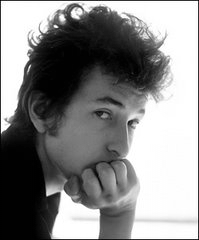Holy shit. This movie is truly an original. Part experimental film, part documentary, and part biopic, the new film from Todd Haynes (Far From Heaven) is nothing less than perhaps the greatest biographical film of all time.
Biopics (an industry-coined term, short for "biographical picture") have become all the rage lately, especially ones about musicians. While most of them have been good (Ray, Walk the Line), there's no denying the fact that they all follow a similar structure and formula. Bob Dylan, always the innovator, wisely decided to wait until a script came along that broke the mold. This film, to which Dylan has given his stamp of approval (by allowing the use of his music) is the first non-documentary telling of his life.
No less than six actors play Dylan at different stages of his life (although none are actually given his name):
- Marcus Carl Franklin, a young black boy, plays Dylan's younger self. He calls himself "Woody Guthrie", an obvious allusion to the fact that Dylan not only worshipped Guthrie, but also (in his younger days) tried to emulate him in every way.
- Ben Whishaw (who has the smallest Dylan role) plays Arthur Rimbaud, a sort of narrator of our story, although, in true Dylan fashion, he is reluctant to explain himself beyond vague phrases and riddles.
- Christian Bale plays Jack Rollins, the character which represents Dylan's transition from simple folk singer to a recognized performer of "protest songs" (more specifically, the time period surrounding his album "The Times They Are a-Changin'"). This story in the film differs from the others in that it is told in a faux-documentary form, with fake interviews of actors playing characters based on real people (such as Julianne Moore, who plays a character based on Joan Baez). Bale's character also returns later on, as we view Dylan's brief Christian reform.
- Cate Blanchett plays Jude Quinn, based on the Don't Look Back-era Dylan. As such, this section is filmed in black and white, like that film. Blanchett, while female, probably gives the best performance as Dylan. It is just simply spot-on.
- Heath Ledger plays Robbie Clark, who represents Dylan during the time his marriage was falling apart (AKA, the Blood on the Tracks period). One of the best uses of Dylan's music in the film is during this section. "Visions of Johanna" plays over the sequence where his wife first realizes it's over. The whole sequence is great, but the best part of it is the beginning - the song fading in, the simultaneous push-ins, the 4 flash cuts, and Ledger's hushed voice-over. Perfect.
- And finally, Richard Gere plays Billy, an aged outlaw and the literal manifestation of Dylan's fascination with Billy the Kid.
I will begin to talk about the complicated narrative structure of the film, which often does not reference events directly, but relies on the audience's prior knowledge of Dylan to fill in the blanks. I must stress this point here: do not attempt to watch this film unless you've seen at least the two main Dylan documentaries, Don't Look Back and No Direction Home, and have read a brief history of his life (this is a good place to start). I say this because the film will make little-to-no sense for someone without a primer in Dylan 101.
Take the scene below, for instance. In this wonderful sequence, the Dylan character who calls himself "Woody Guthrie" goes to visit a dying music legend in the hospital. Only Dylan fans would know that this was based on a true event - Dylan visited his idol and musical inspiration Woody Guthrie as he lay dying in his hospital bed. It was a main turning point in his life, and it allowed him to put down the Guthrie persona and become his own being. Thus, after this scene, the black Dylan character disappears from the film.
Even more potentially confusing is the Gere character, who not only embodies the Billy the Kid persona Dylan took on while working on the film Pat Garrett and Billy the Kid and its soundtrack, but because the film makes liberal use of non-linear structure and cross-cutting, this section is actually a direct comment on the Heath Ledger storyline which is happening right alongside it. As his marriage is breaking up, and Dylan becomes more withdrawn, it's almost as if this Billy character is his fantasy - becoming someone who no one knows, living in a small, simple town and being content with himself. As the town is threatened with destruction, this is representative of Dylan waking up from his depression and finally moving on, as the character hitches a ride on a train (echoing the beginning) and rides away. This makes little sense as we're watching it, but as Billy's dog - his one true companion - struggles to catch up with the fleeing train and fails, Gere mutters "Goodbye, my lady", and we're suddenly aware that he's talking about his wife. We sense his character's loss, and therefore, also Dylan's. It's a brilliant way of portraying something not easily conveyed on screen.
The more I talk about this film, the more amazing I realize it is. It's a must-see for Dylan fans, and even for people who don't know about him - do a little Dylan research and then see this film. It won't be nominated for it, but it deserves the Best Screenplay Oscar. And I haven't even seen There Will Be Blood yet. That's how good it is.


No comments:
Post a Comment